A utility knife is a household object that everyone has at home. It is used for cutting almost anything. Often foldable or retractable, this small knife is sharp enough to cut through cardboard and other materials. You might also know it by names like stationary or razor blade knives. Its size makes it convenient and portable to use.
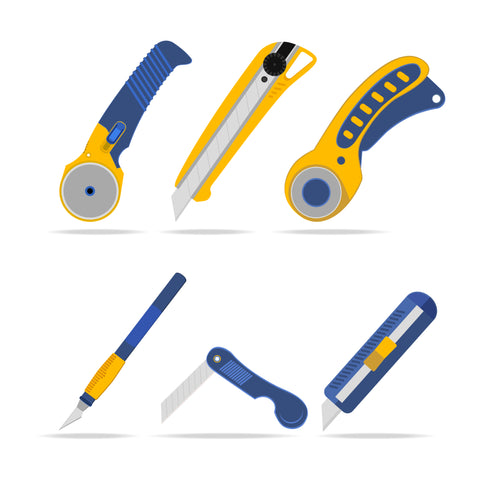
Photo by pp_scout / Depositphotos
Utility knives are designed for multipurpose manual use and come in six different types based on the kind of blade used. Each type serves a particular purpose and is used to cut through various objects such as cardboard, wires, wood, tape, rubber, and plastic. The most frequently used utility knife is the one with a Pointed Tip blade.
- What are utility knives used for?
Have you ever heard people say, “Get that small knife!” for almost anything? Yes, that’s because it has that many uses. Their size and shape make them a versatile tool to use.
- Stripping Wires: This is one of the most common uses of a utility knife. They are used for scoring the jacket of the wire and removing the wire sheath without cutting through the electrical part of the wire.
It is simple to handle a big or small fixture with a utility knife. However, it is crucial to handle it gently to avoid damage to the wire. Also, use it with caution to prevent any injuries.
- Use it as a stationary Knife: From cutting paper to cutting cardboard, it is used in myriad ways while making art. The ease of smoothly scoring the paper makes it a great tool. Likewise, its sharpness is the most appealing feature when cutting more rigid materials like cardboard.
- Wood Carving: This form of artistry has been gaining light recently. These knives make it easier for beginners since it is not an easy task to carve through the wood.
- Removing Screws and Nail Heads: When the walls in your house are repainted or redone, there might be some paint-coated screws or nail heads. The utility knife will come in handy for this purpose when you try to remove it. You just need to gently scratch out the paint or the surrounding bits until it is free enough to pop out. However, be careful not to damage the wall.
- Cutting Up Vinyl Or Carpeted Flooring: Everyone attempts to DIY to cut costs. If you are one among them, try the utility knife.
Removing your floor covering is hard and tough to crack through when you need to change your floor covering. Utility knives can help slit through them and cut them into convenient squares.
They can also be used to cover up your floor. The tricky part is to accurately cut the vinyl covers. But, it is not so difficult with the utility knife in hand. Use the utility knives to help cut the vinyl flooring into perfect squares to fit the room’s floor size.
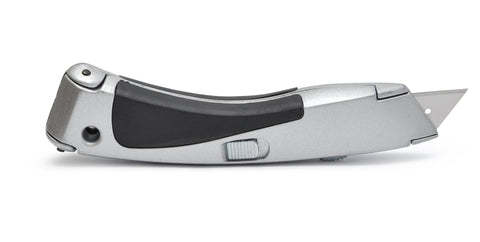
Photo by salamiss / Depositphotos
- Removing Tile Grout: Many people face the problem of grout between tiles. Luckily, the solution is simple! A utility knife makes an excellent tool to scratch out grout. Specialized tools are available for this problem, but a utility knife provides a quick and temporary solution.
- Utility knives in the kitchen: Some utility knives make cutting meat and bones easier in the kitchen. Their sharp and serrated edges help slice through the food effortlessly. It is sometimes better than regular knives as they are crafted to do a clean job, especially with veggies like tomatoes.
- Utility knife as a Sharpener: Artists use the utility knife to sharpen pencils, crayons, and other drawing supplies. They choose it over other sharpeners because of its flexibility to carve out pointier tips of the pencils. Though it looks dangerous, with practice, the art can be mastered.
- Repairing Window Screens: A nylon window screen can get worn out over time because of the environment and dust. To replace it, you just need a new screen to fit into the window’s metal frame and slice off the excess. Your utility knife can make that impeccable cut in a jiffy. Just slice off the excess mesh by sliding it along the edge. It is as simple as that!
- Split Wood Shims: A wood shim is a piece of wood used to adjust door frames or windows. It is a rectangular piece of wood that comes in different sizes. Sometimes, when the shim needs to be divided into smaller rectangles, the best tool is a utility knife, as they are handy. You can trim it to exactly the length you want with this device.
UTILITY KNIFE TYPES
There are six types of utility knives, and each is built differently to perform a particular task. Most people just find the closest blade to cut through something but this method may not always be practical. These six types of utility knives are the most effective with a purpose for each of them.
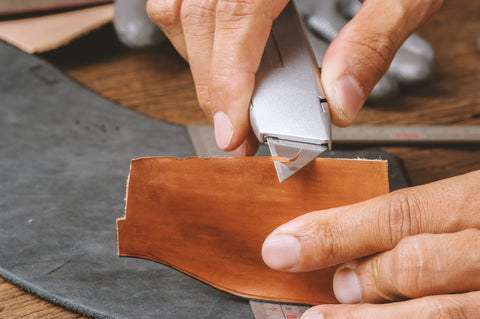
Photo by norgallery / Depositphotos
- Hook Blade – As the name suggests, the hook blade has a small, sharp hook at the edge instead of the classic, long blade. It is used to cut thick and heavy-duty items like linoleum and carpet.
- Scalloped Edge Blade – A scalloped edge blade usually means that the blade has sharp semicircles that line the whole blade.
It is used to cut sensitive objects that can cause a mess. For example, styrofoam cutting can get quite messy. So, for a neat finish, use a scalloped edge blade to cut it. It is also used to cut perfect tomato rings, which can otherwise become quite squishy.
- Serrated Edge Blade – Serrated edge blade is similar to a scalloped edged blade, but instead of a blade lined with semicircles, it is jagged and rough. It is sharp and often used in a sawing motion. These are perfect for cutting thick materials like wood. The sawing motion gives the momentum and friction to cut through dense material like wood. The rough design is also safe to use, so it is a preferred option for utility knives.
- Snap-Off Blade – This was manufactured in Japan in the 1950s after a manufacturer was inspired by how chocolate bars break off. This blade is long and has multiple seams that help snap off one part of the blade at a time, leaving a fresh blade to use. If a blade dulls, instead of having to replace the whole blade, you can just snap off the edge. It lasts longer and is a better option to save your money.
- Pointed Tip Blade – As the name suggests, this utility knife has a pointed tip and a sharp blade. It is used when cutting a hard material that must be punctured first. Examples of materials that can be cut with this include drywall, plastics, and certain fabrics. A hole or cut is first put in with this blade which can then cut the material normally.
- Rounded Tip Blade – It serves almost the opposite of what the pointed tip blades do. It is rounded in the edges, as the name suggests, and is safer to use as it prevents the possibility of accidentally puncturing materials. It is used to slice through soft materials and is perfect for materials like cardboard or foam.
HOW DO YOU CHANGE THE BLADE OF A UTILITY KNIFE?
Is the blade of your knife too dull? Fractured? Maybe even blunted? As easy as it is to throw it away, it is equally easy to change the blade. Changing the blade of a utility knife is cost-effective. The instructions and extra blades often come along with the knife package. Changing the blade can be done in three easy steps :
- Open the body of the utility knife: The body of the knife is usually sealed with one or more screws. Find a screwdriver to unscrew them and take them apart. It will open the body of the knife in two.
- Remove the blade: Most of the blade will be held in a small housing which will also be secured with a screw. Remove the screw using a suitable screwdriver and gently remove the old blade. Make sure to note how the blade was inserted, so the new blade can be inserted the same way.
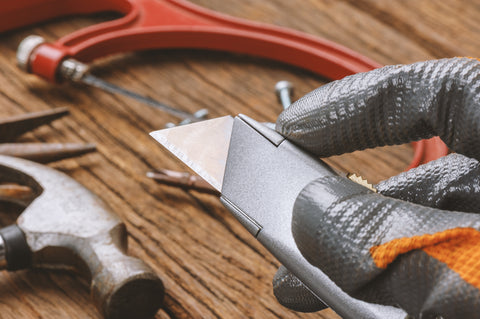
Photo by norgallery / Depositphotos
- Rearranging the Utility Knife: After securing the new blade tightly, screw back the housing. Now you just need to go backward and reassemble the blade. Fasten all the screws properly. Be sure to tighten the blade properly, so you can start working with it again.
Handle the blade carefully, as even a dull blade can still be sharp, and dispose of it properly. To dispose of an old blade, wrap it carefully in paper or some soft material and secure it with tape. This prevents the blade from doing any accidental damage.
SAFETY MEASURES:
It is important to consider some safety precautions while using any kind of blade. These are some things you can do while using a knife :
- Storage – First and foremost, it is important to keep the knife blade folded or retracted when it is not in use or when in storage. It is less dangerous this way and prevents the blade from being damaged.
- Body Position – Place the hand you are not using away from the cutting line. Your body should be positioned away from the cut line too. Maintain good balance to get a proper grip on the knife. Keep your concentration on the knife, and do not be distracted while using it.
- Work Surface – When cutting something, place it on a sturdy surface. The work surface should not be tilting or wobbling and should be steady. Try not to use furniture or any work table as it might leave scratch marks on the surface.
- Condition of the Knife – It is essential to constantly check the knife’s condition before every use. The blade might get dull or rusted over time which is not safe as it may require more effort and pressure to cut. Also, you need to check if the blade is tight enough and not loose.
- Usage – Although it is multipurpose, do not use the utility knife for unsuitable purposes. Some people tend to use it as a replacement for tools like screwdrivers which is dangerous and should be avoided.
WHAT CAN A UTILITY KNIFE CUT?
A utility knife is called so because of its versatility. It can cut many different materials, and some of them are as follows :
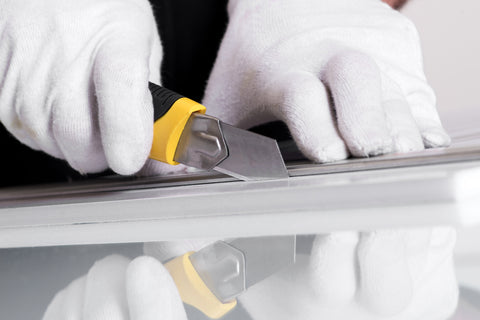
Photo by PHOTOLOGY1971 / Depositphotos
- Art Items – It is used to cut art materials like papers, cardboard, foam, and others. It is a popular choice of artists because it makes smooth cuts.
- Building items – Materials like wood and foam that may be used in any form of construction can be cut with a utility knife.
- Thin Metal – Thin metal and small electrical appliances such as wires and mesh can be cut using a utility knife. It is a must-have piece of equipment for electricians!
- Meat and Bone – Some utility knives are used in kitchens, particularly restaurants. It slices through meat and bones easier than regular knives.
DIFFERENCE BETWEEN A BOX CUTTER AND AN UTILITY KNIFE
A box cutter and a utility knife are devices that function similarly, and therefore, their names are often interchanged. Many people mistake one for another. Even though both can be used for similar functions, such as paper cutting and wire snipping, there are evident differences.
Firstly, the purpose of a box cutter is a little more specific, and yes, you guessed it right! It is designed to open boxes and cut things that are usually sturdy and thick. It comes with a sharp blade that is stronger.
Secondly, the utility knife performs a broader range of functions and thus is better for everyday use. It is more versatile. It is slightly smaller and more craft inclined and is not the best option for box cutting.
Another predominant difference is that a box cutter usually has blades that retract, while utility knives have blades that fold. Other than this, both are fundamentally constructed the same way.

